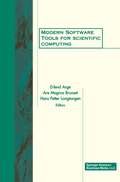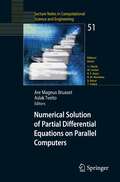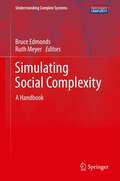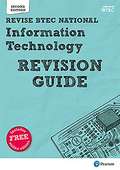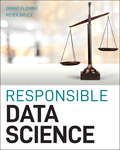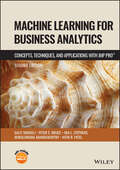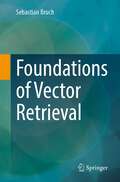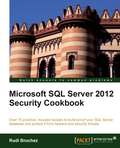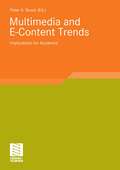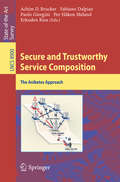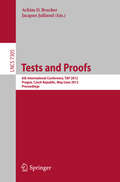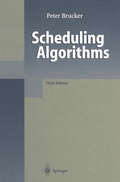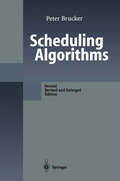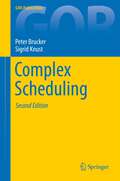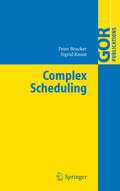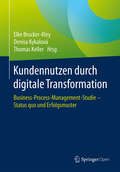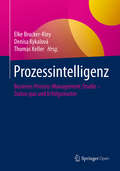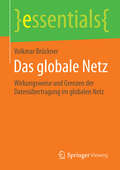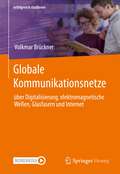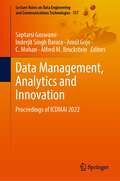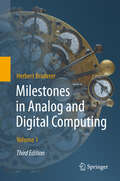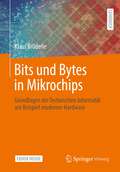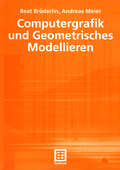- Table View
- List View
Modern Software Tools for Scientific Computing
by A. Bruaset E. Arge Hans Petter LangtangenLooking back at the years that have passed since the realization of the very first electronic, multi-purpose computers, one observes a tremendous growth in hardware and software performance. Today, researchers and engi neers have access to computing power and software that can solve numerical problems which are not fully understood in terms of existing mathemati cal theory. Thus, computational sciences must in many respects be viewed as experimental disciplines. As a consequence, there is a demand for high quality, flexible software that allows, and even encourages, experimentation with alternative numerical strategies and mathematical models. Extensibil ity is then a key issue; the software must provide an efficient environment for incorporation of new methods and models that will be required in fu ture problem scenarios. The development of such kind of flexible software is a challenging and expensive task. One way to achieve these goals is to in vest much work in the design and implementation of generic software tools which can be used in a wide range of application fields. In order to provide a forum where researchers could present and discuss their contributions to the described development, an International Work shop on Modern Software Tools for Scientific Computing was arranged in Oslo, Norway, September 16-18, 1996. This workshop, informally referred to as Sci Tools '96, was a collaboration between SINTEF Applied Mathe matics and the Departments of Informatics and Mathematics at the Uni versity of Oslo.
Numerical Solution of Partial Differential Equations on Parallel Computers (Lecture Notes in Computational Science and Engineering #51)
by Are Magnus Bruaset Aslak TveitoSince the dawn of computing, the quest for a better understanding of Nature has been a driving force for technological development. Groundbreaking achievements by great scientists have paved the way from the abacus to the supercomputing power of today. When trying to replicate Nature in the computer’s silicon test tube, there is need for precise and computable process descriptions. The scienti?c ?elds of Ma- ematics and Physics provide a powerful vehicle for such descriptions in terms of Partial Differential Equations (PDEs). Formulated as such equations, physical laws can become subject to computational and analytical studies. In the computational setting, the equations can be discreti ed for ef?cient solution on a computer, leading to valuable tools for simulation of natural and man-made processes. Numerical so- tion of PDE-based mathematical models has been an important research topic over centuries, and will remain so for centuries to come. In the context of computer-based simulations, the quality of the computed results is directly connected to the model’s complexity and the number of data points used for the computations. Therefore, computational scientists tend to ?ll even the largest and most powerful computers they can get access to, either by increasing the si e of the data sets, or by introducing new model terms that make the simulations more realistic, or a combination of both. Today, many important simulation problems can not be solved by one single computer, but calls for parallel computing.
Simulating Social Complexity: A Handbook (Understanding Complex Systems)
by Bruce Edmonds and Ruth MeyerSocial systems are among the most complex known. This poses particular problems for those who wish to understand them. The complexity often makes analytic approaches infeasible and natural language approaches inadequate for relating intricate cause and effect. However, individual- and agent-based computational approaches hold out the possibility of new and deeper understanding of such systems. Simulating Social Complexity examines all aspects of using agent- or individual-based simulation. This approach represents systems as individual elements having each their own set of differing states and internal processes. The interactions between elements in the simulation represent interactions in the target systems. What makes these elements "social" is that they are usefully interpretable as interacting elements of an observed society. In this, the focus is on human society, but can be extended to include social animals or artificial agents where such work enhances our understanding of human society. The phenomena of interest then result (emerge) from the dynamics of the interaction of social actors in an essential way and are usually not easily simplifiable by, for example, considering only representative actors. The introduction of accessible agent-based modelling allows the representation of social complexity in a more natural and direct manner than previous techniques. In particular, it is no longer necessary to distort a model with the introduction of overly strong assumptions simply in order to obtain analytic tractability. This makes agent-based modelling relatively accessible to a range of scientists. The outcomes of such models can be displayed and animated in ways that also make them more interpretable by experts and stakeholders. This handbook is intended to help in the process of maturation of this new field. It brings together, through the collaborative effort of many leading researchers, summaries of the best thinking and practice in this area and constitutes a reference point for standards against which future methodological advances are judged. This book will help those entering into the field to avoid "reinventing the wheel" each time, but it will also help those already in the field by providing accessible overviews of current thought. The material is divided into four sections: Introductory, Methodology, Mechanisms, and Applications. Each chapter starts with a very brief section called ‘Why read this chapter?’ followed by an abstract, which summarizes the content of the chapter. Each chapter also ends with a section of ‘Further Reading’ briefly describing three to eight items that a newcomer might read next.
Revise BTEC National Information Technology (Revise BTEC Nationals In IT series (PDF))
by Ian Bruce Daniel Richardson Alan JarvisExam Board: Pearson BTEC Academic Level: BTEC National Subject: Information Technology First teaching: September 2016 First Exams: Summer 2017 Ideal for classroom or independent study, this Revision Guide with ActiveBook is the smart choice for learners studying for the externally assessed Units 1 & 2 of the new BTEC Nationals in Information Technology qualifications. The Revision Guide is accompanied by an ActiveBook (eBook) so that learners have the choice and flexibility to access materials anytime or anywhere. The visually engaging format breaks the content down into easily-digestible sections for students and provides hassle-free instant-access revision for learners. Clear specification fit, with revision activities and annotated sample responses for each unit to show students how to tackle the assessed tasks. Written with students in mind - in an informal voice that talks directly to them. Designed to be used alongside the Workbook with clear unit-by-unit correspondence to make it easy to use the books together. Please note: This title does not cover the externally assessed Units 11 or 14, which are required for the Diploma and Extended Diploma Updates to this title If you purchased this title before 3rd April 2017, you will have an older edition. In light of updates to the qualification, there may be changes required to this older edition, which will be outlined at www.pearsonfe.co.uk/BTECchanges. An updated edition of this title will release in time for the new academic year in September 2017. This new edition will reflect updates to the qualification that have been made. If you have the older edition and would like a copy of the new edition, please contact our customer services team, with proof of purchase, on 0845 313 6666 or email customersolutions@pearson.com
Responsible Data Science
by Peter C. Bruce Grant FlemingExplore the most serious prevalent ethical issues in data science with this insightful new resource The increasing popularity of data science has resulted in numerous well-publicized cases of bias, injustice, and discrimination. The widespread deployment of “Black box” algorithms that are difficult or impossible to understand and explain, even for their developers, is a primary source of these unanticipated harms, making modern techniques and methods for manipulating large data sets seem sinister, even dangerous. When put in the hands of authoritarian governments, these algorithms have enabled suppression of political dissent and persecution of minorities. To prevent these harms, data scientists everywhere must come to understand how the algorithms that they build and deploy may harm certain groups or be unfair. Responsible Data Science delivers a comprehensive, practical treatment of how to implement data science solutions in an even-handed and ethical manner that minimizes the risk of undue harm to vulnerable members of society. Both data science practitioners and managers of analytics teams will learn how to: Improve model transparency, even for black box models Diagnose bias and unfairness within models using multiple metrics Audit projects to ensure fairness and minimize the possibility of unintended harm Perfect for data science practitioners, Responsible Data Science will also earn a spot on the bookshelves of technically inclined managers, software developers, and statisticians.
Responsible Data Science
by Peter C. Bruce Grant FlemingExplore the most serious prevalent ethical issues in data science with this insightful new resource The increasing popularity of data science has resulted in numerous well-publicized cases of bias, injustice, and discrimination. The widespread deployment of “Black box” algorithms that are difficult or impossible to understand and explain, even for their developers, is a primary source of these unanticipated harms, making modern techniques and methods for manipulating large data sets seem sinister, even dangerous. When put in the hands of authoritarian governments, these algorithms have enabled suppression of political dissent and persecution of minorities. To prevent these harms, data scientists everywhere must come to understand how the algorithms that they build and deploy may harm certain groups or be unfair. Responsible Data Science delivers a comprehensive, practical treatment of how to implement data science solutions in an even-handed and ethical manner that minimizes the risk of undue harm to vulnerable members of society. Both data science practitioners and managers of analytics teams will learn how to: Improve model transparency, even for black box models Diagnose bias and unfairness within models using multiple metrics Audit projects to ensure fairness and minimize the possibility of unintended harm Perfect for data science practitioners, Responsible Data Science will also earn a spot on the bookshelves of technically inclined managers, software developers, and statisticians.
Machine Learning for Business Analytics: Concepts, Techniques and Applications with JMP Pro
by Peter C. Bruce Mia L. Stephens Galit Shmueli Muralidhara Anandamurthy Nitin R. PatelMACHINE LEARNING FOR BUSINESS ANALYTICS An up-to-date introduction to a market-leading platform for data analysis and machine learning Machine Learning for Business Analytics: Concepts, Techniques, and Applications with JMP Pro®, 2nd ed. offers an accessible and engaging introduction to machine learning. It provides concrete examples and case studies to educate new users and deepen existing users’ understanding of their data and their business. Fully updated to incorporate new topics and instructional material, this remains the only comprehensive introduction to this crucial set of analytical tools specifically tailored to the needs of businesses. Machine Learning for Business Analytics: Concepts, Techniques, and Applications with JMP Pro®, 2nd ed. readers will also find: Updated material which improves the book’s usefulness as a reference for professionals beyond the classroom Four new chapters, covering topics including Text Mining and Responsible Data Science An updated companion website with data sets and other instructor resources: www.jmp.com/dataminingbook A guide to JMP Pro®’s new features and enhanced functionality Machine Learning for Business Analytics: Concepts, Techniques, and Applications with JMP Pro®, 2nd ed. is ideal for students and instructors of business analytics and data mining classes, as well as data science practitioners and professionals in data-driven industries.
Machine Learning for Business Analytics: Concepts, Techniques and Applications with JMP Pro
by Peter C. Bruce Mia L. Stephens Galit Shmueli Muralidhara Anandamurthy Nitin R. PatelMACHINE LEARNING FOR BUSINESS ANALYTICS An up-to-date introduction to a market-leading platform for data analysis and machine learning Machine Learning for Business Analytics: Concepts, Techniques, and Applications with JMP Pro®, 2nd ed. offers an accessible and engaging introduction to machine learning. It provides concrete examples and case studies to educate new users and deepen existing users’ understanding of their data and their business. Fully updated to incorporate new topics and instructional material, this remains the only comprehensive introduction to this crucial set of analytical tools specifically tailored to the needs of businesses. Machine Learning for Business Analytics: Concepts, Techniques, and Applications with JMP Pro®, 2nd ed. readers will also find: Updated material which improves the book’s usefulness as a reference for professionals beyond the classroom Four new chapters, covering topics including Text Mining and Responsible Data Science An updated companion website with data sets and other instructor resources: www.jmp.com/dataminingbook A guide to JMP Pro®’s new features and enhanced functionality Machine Learning for Business Analytics: Concepts, Techniques, and Applications with JMP Pro®, 2nd ed. is ideal for students and instructors of business analytics and data mining classes, as well as data science practitioners and professionals in data-driven industries.
Foundations of Vector Retrieval
by Sebastian BruchThis book presents the fundamentals of vector retrieval. To this end, it delves into important data structures and algorithms that have been successfully used to solve the vector retrieval problem efficiently and effectively. This monograph is divided into four parts. The first part introduces the problem of vector retrieval and formalizes the concepts involved. The second part delves into retrieval algorithms that help solve the vector retrieval problem efficiently and effectively. It includes a chapter each on brand-and-bound algorithms, locality sensitive hashing, graph algorithms, clustering, and sampling. Part three is devoted to vector compression and comprises chapters on quantization and sketching. Finally, the fourth part presents a review of background material in a series of appendices, summarizing relevant concepts from probability, concentration inequalities, and linear algebra. The book emphasizes the theoretical aspects of algorithms and presents related theorems and proofs. It is thus mainly written for researchers and graduate students in theoretical computer science and database and information systems who want to learn about the theoretical foundations of vector retrieval.
Microsoft SQL Server 2012 Security Cookbook
by Rudi BruchezEach recipe comprises step-by-step instructions followed by an analysis of what was done in each task and other useful information. The book is designed so that you can read it chapter by chapter, or look at the list of recipes and refer to them in no particular order. Each example comes with its expected output to make your learning even easier thus enabling you to successfully secure your SQL Server 2012 database. This book is for SQL Server administrators, developers, and consultants who want to secure their SQL Server database with cutting edge techniques for data and code encryption, user authentication and authorization, protection against brute force attacks, denial-of-service attacks, and SQL Injection, securing business intelligence, and more. Working knowledge of SQL Server is expected.
Multimedia and E-Content Trends: Implications for Academia (Smart Media und Applications Research)
by Peter A. BruckThe authors reflect the preoccupation of academia with the latest trends in e-content and communication technologies, such as going mobile or discovering new, innovative interfaces. In addition, they introduce new learning methods with interactive media.
Secure and Trustworthy Service Composition: The Aniketos Approach (Lecture Notes in Computer Science #8900)
by Achim Brucker Fabiano Dalpiaz Paolo Giorgini Per Håkon Meland Erkuden RiosThe Future Internet envisions a move toward widespread use of services as a way of networked interaction. However, while the technologies for developing and deploying services are well established, methods for ensuring trust and security are fewer and less mature. Lack of trust and confidence in composed services and in their constituent parts is reckoned to be one of the significant factors limiting widespread uptake of service-oriented computing.This state-of-the-art survey illustrates the results of the Aniketos – Secure and Trustworthy Composite Services – project (funded under the EU 7th Research Framework Programme). The papers included in the book describe the solutions developed during the 4-year project to establish and maintain trustworthiness and secure behavior in a constantly changing service environment. They provide service developers and providers with a secure service development framework that includes methods, tools, and security services supporting the design-time creation and run-time composition of secure dynamic services, where both the services and the threats are evolving. The 16 chapters are organized in the following thematic sections: state of the art of secure and trustworthy composite services; the Aniketos platform; design-time support framework; run-time support framework; and case studies and evaluation.
Tests and Proofs: 6th International Conference, TAP 2012, Prague, Czech Republic, May 31 -- June 1, 2012. Proceedings (Lecture Notes in Computer Science #7305)
by Achim Brucker Jacques JulliandThis book constitutes the refereed proceedings of the 6th International Conference on Test and Proofs, TAP 2012, held in Prague, Czech Republic, in May/June 2012, as part of the TOOLS 2012 Federated Conferences. The 9 revised full papers presented together with 2 invited papers, 4 short papers and one tutorial were carefully reviewed and selected from 29 submissions. The papers are devoted to the convergence of tests and proofs for developing novel techniques and application that support engineers in building secure, safe, and reliable systems. Among the topics covered are model-based testing; scenario-based testing; complex data structure generation; and the validation of protocols and libraries.
Scheduling Algorithms
by Peter BruckerThe book contains algorithms for classical and complex scheduling problems, new results on scheduling problems arising in flexible manufacturing, and an extensive overview of the area of scheduling. The methods used to solve these problems include: linear programming, dynamic programming, branch-and-bound algorithms, and local search heuristics. In the third edition of the book the complexity status of the different classes of scheduling problems has been updated. New polynomial algorithms for single machine problems with release times and constant processing times have been added.
Scheduling Algorithms
by Peter BruckerBesides scheduling problems for single and parallel machines and shop scheduling problems the book covers advanced models involving due-dates, sequence dependent changeover times and batching. Also multiprocessor task scheduling and problems with multipurpose machines are discussed. The methods used to solve these problems are linear programming, dynamic programming, branch-and-bound algorithms, and local search heuristics. Complexity results for the different classes of deterministic scheduling problems are summarized.
Complex Scheduling (GOR-Publications)
by Peter Brucker Sigrid KnustThis book presents models and algorithms for complex scheduling problems. Besides resource-constrained project scheduling problems with applications also job-shop problems with flexible machines, transportation or limited buffers are discussed. Discrete optimization methods like linear and integer programming, constraint propagation techniques, shortest path and network flow algorithms, branch-and-bound methods, local search and genetic algorithms, and dynamic programming are presented. They are used in exact or heuristic procedures to solve the introduced complex scheduling problems. Furthermore, methods for calculating lower bounds are described. Most algorithms are formulated in detail and illustrated with examples. In this second edition some errors were corrected, some parts were explained in more detail, and new material has been added. In particular, further generalizations of the RCPSP, additional practical applications and some more algorithms were integrated.
Complex Scheduling (GOR-Publications)
by Peter Brucker Sigrid KnustScheduling problems have been investigated since the late ?fties. Two types of applications have mainly motivated research in this area: project planning and machine scheduling. While in machine scheduling a large number of speci?c scheduling situations depending on the machine environment and the job c- racteristicshavebeenconsidered, theearlyworkinprojectplanninginvestigated scheduling situations with precedence constraints between activities assuming that su?cient resources are available to perform the activities. More recently, in project scheduling scarce resources have been taken into account leading to so-called resource-constrained project scheduling problems. On the other hand, also in machine scheduling more general and complex problems have been - vestigated. Due to these developments today both areas are much closer to each other. Furthermore, applications like timetabling, rostering or industrial scheduling are connected to both areas. This book deals with such complex scheduling problems and methods to solve them. It consists of three parts: The ?rst part (Chapters 1 and 2) contains a description of basic scheduling models with applications and an introduction into discrete optimization (covering complexity, shortest path algorithms, linear programming, network ?ow algorithms and general optimization methods). In the second part (Chapter 3) resource-constrained project scheduling problems are considered. Especially, methods like constraint propagation, branch-a- bound algorithms and heuristic procedures are described. Furthermore, lower bounds and general objective functions are discussed.
Kundennutzen durch digitale Transformation: Business-Process-Management-Studie – Status quo und Erfolgsmuster
by Elke Brucker-Kley Denisa Kykalová Thomas KellerDieses Open-Access-Buch präsentiert die Ergebnisse einer qualitativen und quantitativen Studie, die das Institut für Wirtschaftsinformatik in Kooperation mit dem Institut für Marketingmanagement der ZHAW School of Management and Law 2016 durchgeführt hat. Ziel der Business-Process-Management-Studie, mit der seit 2011 regelmäßig Status quo und Best Practices im deutschsprachigen Raum erhoben werden, war es, die Rolle des Prozessmanagements als Gestaltungshebel der digitalen Transformation zu beleuchten.
Prozessintelligenz: Business-Process-Management-Studie – Status quo und Erfolgsmuster
by Elke Brucker-Kley Denisa Kykalová Thomas KellerUm die Wirksamkeit des Prozessmanagements zu erhöhen, braucht es eine Brücke zum operativen Geschäft. Prozessintelligenz bietet hierfür hilfreiche Ansatzpunkte. Die Process-Management-Studie 2015 des Instituts für Wirtschaftsinformatik an der Zürcher Hochschule für Angewandte Wissenschaften ZHAW School of Management and Law widmet sich diesem Thema und beleuchtet Status quo und Erfolgsmuster. In Fallstudien mit fünf Unternehmen werden Herausforderungen, Lösungsansätze und Nutzen von Prozessintelligenz aufgezeigt. Die Ergebnisse einer Online-Befragung zur Ausrichtung des Prozessmanagements und zum Methoden- und Werkzeugeinsatz bei Unternehmen komplettieren das Bild.
Das globale Netz: Wirkungsweise und Grenzen der Datenübertragung im globalen Netz (essentials)
by Volkmar BrücknerVolkmar Brückner gibt einen Überblick über die Datenübertragung im Festnetz, durch Mobilfunk oder Satelliten sowie über globale mobile und optische Netze. Grenzen und Fehlerquellen für das Festnetz und die Übertragung bei der mobilen Kommunikation sowie Problemfelder in Technik und Ökologie werden angesprochen.
Globale Kommunikationsnetze: über Digitalisierung, elektromagnetische Wellen, Glasfasern und Internet (erfolgreich studieren)
by Volkmar BrücknerAufbauend auf gymnasialen Kenntnissen werden die Zusammenhänge zwischen Glasfaser-Festnetz als Grundlage für schnelle Datenübertragung und mobilen Geräten wie Smartphones als Zugang zu Informationen immer und von überall geschildert. Dabei werden vorrangig Methoden der digitalen Informationsübertragung behandelt. Besonderer Wert wird anhand von Beispielen auf die Entwicklung von Fähigkeiten gelegt, technische Probleme in eine „Ingenieurssprache“ zu übertragen. Zudem werden Probleme der Datensicherheit und deren mögliche Lösungen in der Zukunft an Beispielen erläutert.
Data Management, Analytics and Innovation: Proceedings of ICDMAI 2022 (Lecture Notes on Data Engineering and Communications Technologies #137)
by Alfred M. Bruckstein C. Mohan Saptarsi Goswami Inderjit Singh Barara Amol GojeThis book presents the latest findings in the areas of data management and smart computing, big data management, artificial intelligence, and data analytics, along with advances in network technologies. The book is a collection of peer-reviewed research papers presented at Sixth International Conference on Data Management, Analytics and Innovation (ICDMAI 2022), held virtually during January 14–16, 2022. It addresses state-of-the-art topics and discusses challenges and solutions for future development. Gathering original, unpublished contributions by scientists from around the globe, the book is mainly intended for a professional audience of researchers and practitioners in academia and industry.
Milestones in Analog and Digital Computing
by Herbert BrudererThis Third Edition is the first English-language edition of the award-winning Meilensteine der Rechentechnik; illustrated in full color throughout in two volumes. The Third Edition is devoted to both analog and digital computing devices, as well as the world's most magnificient historical automatons and select scientific instruments (employed in astronomy, surveying, time measurement, etc.). It also features detailed instructions for analog and digital mechanical calculating machines and instruments, and is the only such historical book with comprehensive technical glossaries of terms not found in print or in online dictionaries. The book also includes a very extensive bibliography based on the literature of numerous countries around the world.Meticulously researched, the author conducted a worldwide survey of science, technology and art museums with their main holdings of analog and digital calculating and computing machines and devices, historical automatons and selected scientific instruments in order to describe a broad range of masterful technical achievements. Also covering the history of mathematics and computer science, this work documents the cultural heritage of technology as well.
Bits und Bytes in Mikrochips: Grundlagen der Technischen Informatik am Beispiel moderner Hardware
by Klaus BrüderleDieses Lehrbuch bietet einen gut verständlichen Einstieg in die technischen Grundlagen der Informatik, ohne tiefgehende mathematische Vorkenntnisse vorauszusetzen. Dank zahlreicher Übungen und Lösungen eignet sich das Buch hervorragend zum Selbststudium.Neben Grundkenntnissen der Computertechnik werden ebenso die technischen Grundlagen der Industrie 4.0 vermittelt. Ob Sie sich im Studium oder in der Ausbildung befinden, sich für digitale Berufe umqualifizieren möchten oder einfach ein interessierter Laie sind, dieses Buch unterstützt Sie bei Ihrer digitalen Weiterbildung.Der InhaltZeichen und Bits im Computer: Mensch und MaschineVerbindung der Chips und Datentransport (PCIe, DMI, USB, ThunderboltDatenträger (HD, SSD), IOPS, Protokolle (AHCI, NVMe) und Schnittstellen (M.2, U.2), Intel Serie-100 - 500-ChipsätzeArbeitsspeicher – Zwischenspeicher (Cache)Prozessor-Technologien: AVX, FMA3/4, FP64-Op., Prozessor-Leistungen (Intel-AMD), GPGPU, IPC, Multithreading, ACPI, P-, C- und S-States, TDP, Power Limits (Comet Lake u. Rocket Lake), TDP-Fenster, Turbo Boost 2.0, Turbo Max Technik 3.0, Thermal Velocity Boost und Adaptiver Boost, Current Limit Throttling, PWM-Regelung.Die ZielgruppenAn digitaler Weiterbildung InteressierteSchüler*innen mit dem Fach InformatikSchüler*innen an Berufsfachschulen, Technikerschulen mit Schwerpunkt Informatik und Informatik-Profil-Schulen (IPS)Techniker-Lehrgänge (DAA-Technikum, Fachinformatiker)Studierende der Fächer Informatik, Mechatronik u. a.Der AutorDipl. Ing. (FH) Klaus Brüderle war Lehrer für Physik und Informatik und verfügt über vier Jahrzehnte Erfahrung in der IT-Bildung.
Computergrafik und Geometrisches Modellieren (XLeitfäden der Informatik)
by Beat Brüderlin Andreas MeierGrundlagen der Computergrafik und des Geometrischen Modellierens werden mit diesem Buch dargestellt. Es behandelt neuere rasterbasierte Techniken (z.B. Texturmapping und Anti-Aliasing), die in modernen Grafikbibliotheken und Grafikkarten von PCs üblich sind. Daneben werden Ray-Tracing und Radiosity Methoden und objektraum-definierte Modelliertechniken, sowie effiziente Algorithmen der Geometrie grundlegend besprochen. Zu den einzelnen Kapiteln sind Übungsaufgaben angeführt.
